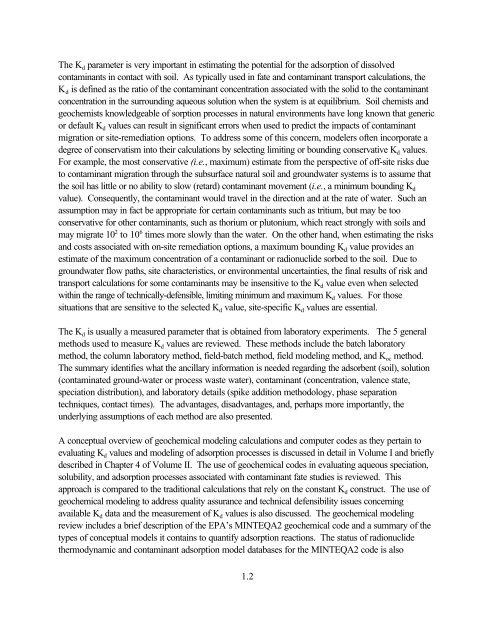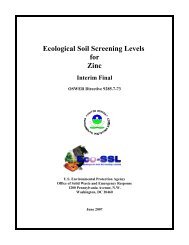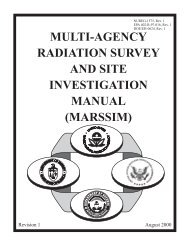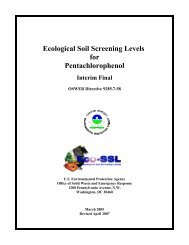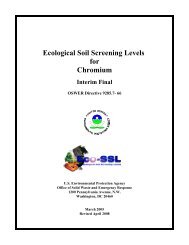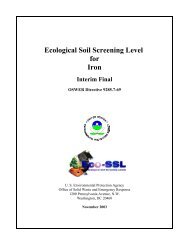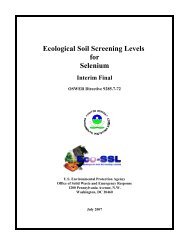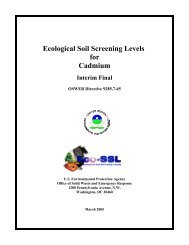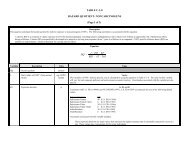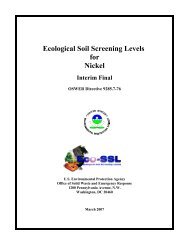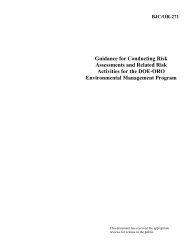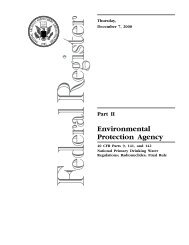Understanding Variation in Partition Coefficient, Kd, Values Volume II
Understanding Variation in Partition Coefficient, Kd, Values Volume II
Understanding Variation in Partition Coefficient, Kd, Values Volume II
Create successful ePaper yourself
Turn your PDF publications into a flip-book with our unique Google optimized e-Paper software.
The K d parameter is very important <strong>in</strong> estimat<strong>in</strong>g the potential for the adsorption of dissolved<br />
contam<strong>in</strong>ants <strong>in</strong> contact with soil. As typically used <strong>in</strong> fate and contam<strong>in</strong>ant transport calculations, the<br />
K d is def<strong>in</strong>ed as the ratio of the contam<strong>in</strong>ant concentration associated with the solid to the contam<strong>in</strong>ant<br />
concentration <strong>in</strong> the surround<strong>in</strong>g aqueous solution when the system is at equilibrium. Soil chemists and<br />
geochemists knowledgeable of sorption processes <strong>in</strong> natural environments have long known that generic<br />
or default K d values can result <strong>in</strong> significant errors when used to predict the impacts of contam<strong>in</strong>ant<br />
migration or site-remediation options. To address some of this concern, modelers often <strong>in</strong>corporate a<br />
degree of conservatism <strong>in</strong>to their calculations by select<strong>in</strong>g limit<strong>in</strong>g or bound<strong>in</strong>g conservative K d values.<br />
For example, the most conservative (i.e., maximum) estimate from the perspective of off-site risks due<br />
to contam<strong>in</strong>ant migration through the subsurface natural soil and groundwater systems is to assume that<br />
the soil has little or no ability to slow (retard) contam<strong>in</strong>ant movement (i.e., a m<strong>in</strong>imum bound<strong>in</strong>g K d<br />
value). Consequently, the contam<strong>in</strong>ant would travel <strong>in</strong> the direction and at the rate of water. Such an<br />
assumption may <strong>in</strong> fact be appropriate for certa<strong>in</strong> contam<strong>in</strong>ants such as tritium, but may be too<br />
conservative for other contam<strong>in</strong>ants, such as thorium or plutonium, which react strongly with soils and<br />
may migrate 10 2 to 10 6 times more slowly than the water. On the other hand, when estimat<strong>in</strong>g the risks<br />
and costs associated with on-site remediation options, a maximum bound<strong>in</strong>g K d value provides an<br />
estimate of the maximum concentration of a contam<strong>in</strong>ant or radionuclide sorbed to the soil. Due to<br />
groundwater flow paths, site characteristics, or environmental uncerta<strong>in</strong>ties, the f<strong>in</strong>al results of risk and<br />
transport calculations for some contam<strong>in</strong>ants may be <strong>in</strong>sensitive to the K d value even when selected<br />
with<strong>in</strong> the range of technically-defensible, limit<strong>in</strong>g m<strong>in</strong>imum and maximum K d values. For those<br />
situations that are sensitive to the selected K d value, site-specific K d values are essential.<br />
The K d is usually a measured parameter that is obta<strong>in</strong>ed from laboratory experiments. The 5 general<br />
methods used to measure K d values are reviewed. These methods <strong>in</strong>clude the batch laboratory<br />
method, the column laboratory method, field-batch method, field model<strong>in</strong>g method, and K oc method.<br />
The summary identifies what the ancillary <strong>in</strong>formation is needed regard<strong>in</strong>g the adsorbent (soil), solution<br />
(contam<strong>in</strong>ated ground-water or process waste water), contam<strong>in</strong>ant (concentration, valence state,<br />
speciation distribution), and laboratory details (spike addition methodology, phase separation<br />
techniques, contact times). The advantages, disadvantages, and, perhaps more importantly, the<br />
underly<strong>in</strong>g assumptions of each method are also presented.<br />
A conceptual overview of geochemical model<strong>in</strong>g calculations and computer codes as they perta<strong>in</strong> to<br />
evaluat<strong>in</strong>g K d values and model<strong>in</strong>g of adsorption processes is discussed <strong>in</strong> detail <strong>in</strong> <strong>Volume</strong> I and briefly<br />
described <strong>in</strong> Chapter 4 of <strong>Volume</strong> <strong>II</strong>. The use of geochemical codes <strong>in</strong> evaluat<strong>in</strong>g aqueous speciation,<br />
solubility, and adsorption processes associated with contam<strong>in</strong>ant fate studies is reviewed. This<br />
approach is compared to the traditional calculations that rely on the constant K d construct. The use of<br />
geochemical model<strong>in</strong>g to address quality assurance and technical defensibility issues concern<strong>in</strong>g<br />
available K d data and the measurement of K d values is also discussed. The geochemical model<strong>in</strong>g<br />
review <strong>in</strong>cludes a brief description of the EPA’s MINTEQA2 geochemical code and a summary of the<br />
types of conceptual models it conta<strong>in</strong>s to quantify adsorption reactions. The status of radionuclide<br />
thermodynamic and contam<strong>in</strong>ant adsorption model databases for the MINTEQA2 code is also<br />
1.2


